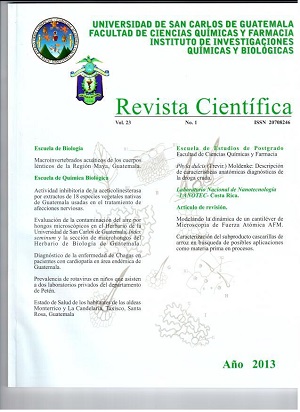Assessment of air pollution by microscopic fungi in the Herbarium of the UNiversity of San Carlos of Guatemala, Index section Seminum and macrofungi of Guatemala Biology Herbarium
Keywords:
air quality, microscopic fungi, biocolector, herbarium, air samplingAbstract
Abstract
The indoor and outdoor quality air was determined at the University of San Carlos of GuatemalaHerbarium (USCG Herbarium), the Index seminum and macrofungi section of Biology of GuatemalaHerbarium (BIGU Herbarium). It was used a volumetric impactation technic through a biocolectorin order to collect microscopic fungi. Sampling was carried out from October 2011 through March2012. Further identification was performed through microscopic observation using lactophenol bluestaining and also using API 20C AUX was for yeast identification. Results indicate that in USCGHerbarium environments, the highest concentration in the outdoor 3580 UFC/m3 and 300 UFC/m3for the indoor, Index seminum 1860 UFC/m3 for the outdoor and 2300 UFC/m3 for the indoor, tomicrofungi section of BIGU Herbarium the highest concentration was 2790 UFC/m3 for the outdoorand 1630 UFC/m3 for the indoor.During the months in wich the sampling was carried out, it was observed that the predominant fungiin both environments and in all sampled areas were Penicillium sp, Cladosporium sp y Aspergillussp. It was possible to isolate fungal genera of great importance for its cellulolytic and phytopathogenicaction, such as Aspergillus sp., Penicillium sp., Fusarium sp. y Paecilomyces sp. The isolation ofthe fungal genera made it possible to create a strain library applying the mineral oil conservationtechnique.It was created a guide containing information about cleaning procedures according to biosafetyinfrastructure and raw materials for each establishment.
Keywords:
Air quality, microscopic fungi, biocolector, herbarium, air sampling.
References
Referencias
Alright, D. (2001). Human health effects of
airborne mycotoxins exposure in fungicontaminated
indoor environment.
Professional Safety. Estados Unidos: Autor.
Angulo, J., Mediavilla, I., Bustos, I. &
Domínguez, E. (1999). Especies fúngicas
aisladas de las hojas de encina (Quercus
rotundifolia) en el Parque Natural de
Hornachuelos (Córdoba). XIII Simposio
de Botánica Criptogámica. Madrid.
Arenas, R. (2,003).Micología Médica ilustrada.
ed. México: McGraw Hill Interamericana.
Berlongieri, A. (1999) Differences in the amount
of fungi found in the air indoors and
outdoors. J. Introductory Micro- biol. 2:
-11.
Calderón, C., Lacey, J., McCartney, A. & Rosas,
I. (1997). Influence of urban climate upon
distribution of airborne Deuteromycete
spore concentration in México City.
Biometeorol. 40(3) pp. 71 – 80.
Castañeda E., Montes M. y Avelino F., (2006).
Cuantificación de bioaerosoles en las áreas
de proceso de una industria zapatera y su
relación con la salud de los trabajadores,
Enfermedades Infecciosas y Microbiología.
:1-5.
Emberlin, J., Newman, T. & Bryant, R. (1995).
The incidence of fungal spores in the
ambient air and inside homes: evidence
from London. Revista Aerobiologia 11 (2),
-258.
Emberlin, J., Newman, T. & Bryant, R. (1995).
The incidence of fungal spores in the
ambient air and inside homes: evidence
from London. Revista Aerobiologia 11 (2),
-258.
Fernández, D., Valencia, R., M, Molinar., T,
Vega. & Sagües, E. (1998). Daily and
seasonal variations of Alternaria and
Cladosporium airborne spores in León.
Revista Aerobiologia. (14)2, 215-220.
Gallo, F., Valenti P., Colaizzi, P., Sclocchi, M.,
Pasquariello, G., Scorrano, M… &
Persiana A. (1996). Research on the
viability of fungal spores in relation to
different microclimates and materials.
International Conference on Conservation
and Restopration of Archive and Library
Materials. Revista Erice. 12(1). 177-193.
Latge, J. (1999). Aspergillus fumigatus and
aspergilosis. Revista Clinical Microbiol.
:310-350.
VOL. 23 No 1 REVISTA CIENTÍFICA
AÑO 2013
INSTITUTO DE INVESTIGACIONES QUÍMICAS Y BIOLÓGICAS
FACULTAD DE CIENCIAS QUÍMICAS Y FARMACIA
UNIVERSIDAD DE SAN CARLOS DE GUATEMALA
Mediavilla, A., Angulo, J., Infante, F., Comtois,
P. & Domínguez, E. (1998). Prelimi- nary
stadistical modeling of the presence of
two conidial types of Cladosporium in the
atmosphere of Córdoba. Spain .
Aerobiologia 14(2,3): 229-234.
Michalski, S. (2000). Guideli for Humidity and
Temperature for Canadian Archives.
Canadian, Ottawa: Conservation Institute.
Milagros, C. y Nieves, R. (1994). Principios
básicos de la conservación documental y
causas de su deterioro. Dirección General
de Bellas Artes y Bienes Culturales.
Petushkova, J. & Kandyba, P. (1999).
Aeromicrobiological studies in the
Moscow cathedrals. Aerobiología. 15(4).
-201.
Pitt, J. (1986). A laboratory guide to common
Penicillium species. Commonwealth
Scientific and Industrial Research
Organisation, 18 (3), 25.
Rico M. (1998). Fundamentos de Microbiología.
Santa Fe de Bogotá, Colombia: Centro
Editorial Javeriano., p. 27-32
Rojas, D., Ojas, J., Espinosa, G., Espinosa, A.,
González, C. Vidal, G., Zaragoza, P. &
Aragoza. Caracterización aerobiológica
de ambientes intramuro en presencia de
cubiertas vegetales. Revista internacional
Contam. 26 (4) 279-289.
Rosas, I., Calderón, C., Martínez, L., Ulloa, M.
& Lacey, J. (1997). Indoor and outdoor
airborne fungal propagule concentrations
in Mexico city. Revista Aerobiología 13
(1): 23-30.
Sanchez,C., y Martinez, P. (1997). Factores que
favorecen el crecimiento fungico. Madrid,
España: Autor.
Yang, C., y Johanning, E. (1997): Airborne
fungi and mycotoxins. Manual of
environmental microbiology. Estados
Unidos, Washington: American Society
for Microbiology.

